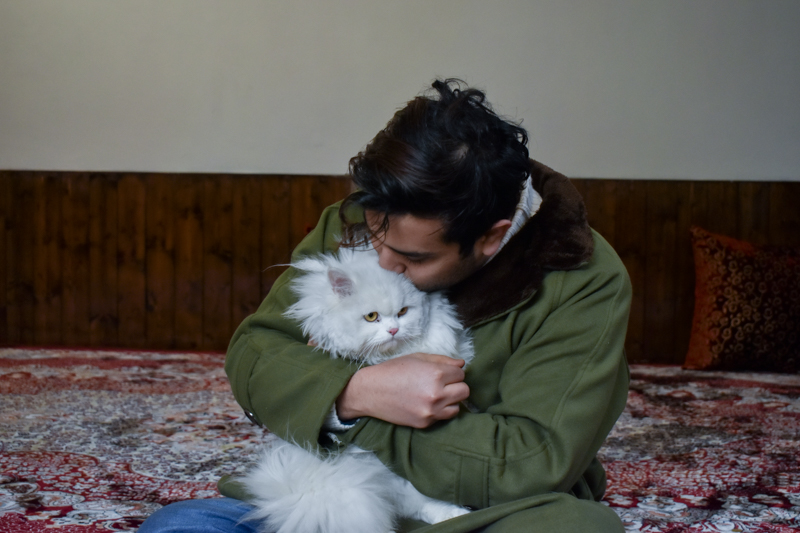Kashmir’s Cat Owners in a Frenzy Over Viral Misinformation
By: Javid Amin
Srinagar 04 March 2025 : Kashmir, a region known for its breathtaking landscapes and rich cultural heritage, recently witnessed an unusual wave of panic. This time, however, the concern was not over politics or security but over an innocent household pet—the cat. Viral social media posts and misinterpreted warnings from veterinarians led to widespread fear, misinformation, and a surge in veterinary visits.
What started as a professional advisory on feline health quickly spiraled into a frenzy, with pet owners rushing to clinics, fearing that their beloved cats could be carrying deadly infections or causing miscarriages among pregnant women. Despite efforts by authorities and veterinarians to dispel myths, the paranoia spread fast, reflecting the power of misinformation in today’s digital age.
How Did the Panic Begin?
The chain reaction was set off in January when veterinarians in Kashmir issued a public advisory regarding an increase in feline infections. The rise in cases was attributed to a lack of proper vaccinations and the mishandling of stray cats. Given the growing number of cat adoptions and the increasing presence of pet stores selling expensive breeds, the warning aimed to encourage responsible pet ownership.
However, the advisory was soon distorted by misleading social media posts and exaggerated news reports. Suddenly, there were claims that cats were responsible for transmitting deadly infections to humans. Some posts even went as far as stating that cat-borne diseases could lead to miscarriages in pregnant women.
The spread of such misinformation created an atmosphere of fear, compelling cat owners to question the safety of their pets. Within days, panic-stricken individuals began seeking medical advice, while veterinarians faced an unprecedented surge in consultations.
Veterinary Clinics Flooded with Concerned Pet Owners
As the rumors gained traction, pet clinics in Kashmir witnessed an overwhelming increase in the number of feline patients.
According to Dr. Altaf Gilani, the head of the main animal hospital in Srinagar, the numbers spoke for themselves. “In the first seven weeks of this year alone, we examined 2,594 cats. That’s a staggering jump from the 1,010 cats we treated in the same period last year. The difference is undeniable—it’s the impact of social media hysteria.”
Many pet owners, like Mir Mubashir, a local businessman from Srinagar, admitted to being deeply unsettled. “When I read those posts, my heart sank. I immediately took my Persian cat, Liger, to the vet, just to be sure she was fine. Only after the doctor reassured me did I feel relieved.”
Veterinarians across the region worked tirelessly to reassure pet owners, reiterating that keeping cats was completely safe as long as proper hygiene, vaccinations, and deworming protocols were followed.
The Science Behind Cat-Related Diseases: Separating Facts from Fiction
To address the growing concerns, it is essential to understand the scientific reality of diseases associated with cats. While there are some zoonotic diseases (infections that can be transmitted from animals to humans), they are preventable and not as dangerous as claimed by the viral misinformation.
1. Toxoplasmosis and Pregnancy—A Misunderstood Connection
One of the biggest fears spread by viral posts was that cats could cause miscarriages in pregnant women. This claim is linked to a parasite called Toxoplasma gondii, which can be found in cat feces. However, the risk of transmission from a pet cat is extremely low. Studies show that humans are more likely to contract toxoplasmosis from handling raw meat or consuming unwashed vegetables than from pet cats.
2. Cat-Scratch Disease (CSD)
Another concern was the spread of Bartonella henselae, a bacteria found in cats that can lead to Cat-Scratch Disease (CSD). However, the condition is mild and can be avoided by maintaining proper hygiene and handling cats gently to prevent scratches.
3. Rabies and Other Feline Infections
Rabies is a real threat, but it affects many animals, not just cats. As long as pet cats are vaccinated, the risk of rabies transmission is eliminated. Other common feline infections, such as ringworm and respiratory illnesses, can be prevented through responsible pet care.
Experts emphasize that instead of fearing cats, pet owners should focus on responsible animal care, including regular veterinary check-ups, vaccinations, and proper hygiene practices.
The Cultural and Psychological Role of Cats in Kashmir
Cats are not just pets in Kashmir; they hold cultural and emotional significance. Islamic traditions regard cats as noble and intelligent creatures, emphasizing their cleanliness. Prophet Muhammad was known to be fond of cats, further embedding their revered status in Muslim communities.
Beyond religion, the psychological benefits of pet ownership are immense. Kashmir, a region marked by political turmoil and frequent lockdowns, has seen a significant rise in pet adoptions, particularly during the COVID-19 pandemic. Cats, much like pigeons, have become a source of emotional comfort for many residents.
During the lockdowns, numerous families took in stray cats, offering them shelter and companionship. For children, playing with pets provided much-needed emotional relief in an otherwise stressful environment. Experts even labeled this trend as “pet therapy,” highlighting the role of animals in alleviating stress and improving mental well-being.
Government and Veterinary Response: Debunking Misinformation
Realizing the growing panic, Kashmir’s animal husbandry department swiftly intervened. Officials issued a public statement clarifying that keeping cats as pets posed no threat to humans, provided they were cared for properly.
“There is no scientific evidence to support the rumors being spread. Cats are safe to keep as pets, provided basic hygiene measures are followed,” the department stated.
Despite these efforts, misinformation continues to spread rapidly in today’s digital world. Experts emphasize the importance of fact-checking sources before sharing information online. “Social media is a powerful tool, but it can also be dangerous when false information spreads unchecked. We urge people to rely on credible sources for health-related concerns,” said Dr. Gilani.
Conclusion: A Lesson in Media Literacy and Responsible Pet Ownership
The cat panic in Kashmir serves as a cautionary tale about the impact of misinformation. While social media connects people and provides valuable information, it can also amplify fear and misinformation.
For pet owners, this incident underscores the importance of relying on veterinary professionals for health concerns rather than social media posts. Proper vaccinations, deworming, and hygiene are key to ensuring both pets and their owners stay healthy.
For the wider community, this episode highlights the need for better media literacy. Understanding how misinformation spreads and learning to verify sources can prevent unnecessary panic in the future.
At the heart of this crisis is a simple truth: Cats are not a threat—they are cherished companions. By fostering responsible pet ownership and critical thinking, Kashmir’s cat lovers can continue to enjoy the unconditional love and companionship their feline friends bring.



